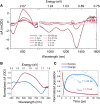Enhanced sub-1 eV detection in organic photodetectors through tuning polymer energetics and microstructure
- PMID: 37285428
- PMCID: PMC10246890
- DOI: 10.1126/sciadv.adh2694
Enhanced sub-1 eV detection in organic photodetectors through tuning polymer energetics and microstructure
Abstract
One of the key challenges facing organic photodiodes (OPDs) is increasing the detection into the infrared region. Organic semiconductor polymers provide a platform for tuning the bandgap and optoelectronic response to go beyond the traditional 1000-nanometer benchmark. In this work, we present a near-infrared (NIR) polymer with absorption up to 1500 nanometers. The polymer-based OPD delivers a high specific detectivity D* of 1.03 × 1010 Jones (-2 volts) at 1200 nanometers and a dark current Jd of just 2.3 × 10-6 ampere per square centimeter at -2 volts. We demonstrate a strong improvement of all OPD metrics in the NIR region compared to previously reported NIR OPD due to the enhanced crystallinity and optimized energy alignment, which leads to reduced charge recombination. The high D* value in the 1100-to-1300-nanometer region is particularly promising for biosensing applications. We demonstrate the OPD as a pulse oximeter under NIR illumination, delivering heart rate and blood oxygen saturation readings in real time without signal amplification.
Figures





References
-
- Statista dossier on the internet of things (IoT), 2022, pp. 1–34, www.statista.com/study/27915/internet-of-things-iot-statista-dossier/.
-
- V. Jahmunah, V. K. Sudarshan, S. L. Oh, R. Gururajan, R. Gururajan, X. Zhou, X. Tao, O. Faust, E. J. Ciaccio, K. H. Ng, U. R. Acharya, Future IoT tools for COVID-19 contact tracing and prediction: A review of the state-of-the-science. Int. J. Imaging Syst. Technol. 31, 455–471 (2021). - PMC - PubMed
-
- R. Ollearo, X. Ma, H. B. Akkerman, M. Fattori, M. J. Dyson, A. J. J. M. Van Breemen, S. C. J. Meskers, W. Dijkstra, R. A. J. Janssen, G. H. Gelinck, Vitality surveillance at distance using thin-film tandem- like narrowband near-infrared photodiodes with light-enhanced responsivity. Sci. Adv. 9, eadf9861 (2023). - PMC - PubMed
-
- N. Li, N. Eedugurala, J. D. Azoulay, T. N. Ng, A filterless organic photodetector electrically switchable between visible and infrared detection. Cell Rep. Phys. Sci. 3, 100711 (2022).
-
- S. Park, K. Fukuda, M. Wang, C. Lee, T. Yokota, H. Jin, H. Jinno, H. Kimura, P. Zalar, N. Matsuhisa, S. Umezu, G. C. Bazan, T. Someya, Ultraflexible near-infrared organic photodetectors for conformal photoplethysmogram sensors. Adv. Mater. 30, 1802359 (2018). - PubMed
LinkOut - more resources
Full Text Sources
Miscellaneous

